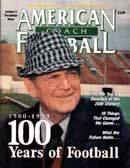AMERICAN FOOTBALL MONTHLY THE #1 RESOURCE FOR FOOTBALL COACHES
Article CategoriesAFM Magazine
|
Lightning BoltsDefensive Line Drillsby: Wayne Nunnely Defensive Line Coach,San Diego Chargers © More from this issue Very quietly, the San Diego Chargers defense has been among the NFL's elite forces during the 1990s. The Lightning Bolts led the AFM in fewest total yards allowed last season and topped the conference in fewest rushing yards allowed for the fourth time this decade. One of the primary reasons for this success has been the Chargers' defensive line play. In order to have an effective defense, you must start with a defensive line that can put pressure on the passer. If the quarterback does not have time to throw the football, the passing game has very little chance at success. And, as you know, that means the offense won't have much luck running the ball, either. Pressure on the passer explemplifies the spirit and aggressiveness of a strong defensive team. Every pass rusher must be intense and hell-bent on getting to the quart....The full article can only be seen by subscribers.
|
|
|||||||
| HOME |
MAGAZINE |
SUBSCRIBE | ONLINE COLUMNISTS | COACHING VIDEOS |
Copyright 2026, AmericanFootballMonthly.com
All Rights Reserved





